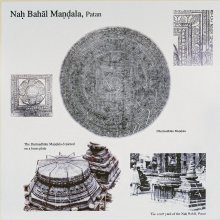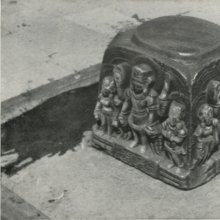Patan, Paṭaṉ, Pāṭaṉ, Pāṭāṇ: 3 definitions
Introduction:
Patan means something in the history of ancient India, Hindi, Tamil. If you want to know the exact meaning, history, etymology or English translation of this term then check out the descriptions on this page. Add your comment or reference to a book if you want to contribute to this summary article.
Images (photo gallery)
(+56 more images available)
India history and geography
Source: archive.org: Songs of NepalPatan (Lalitapaṭṭana) refers to one of the three ancient kingdoms of Nepal.—It is noticeable that among the three principal cities in the Valley, Bhaktagrāma (Bhatgaon), also called Bhaktapura or Dharmapaṭṭana, distinguished itself as a center of predominantly Hindu pursuits, while Lalitapaṭṭana (Patan) favored Buddhist texts, and scholars residing at Kāntipura (Kathmandu) devoted themselves to the interpretation of Buddhist as well as of Hindu works.

The history of India traces the identification of countries, villages, towns and other regions of India, as well as mythology, zoology, royal dynasties, rulers, tribes, local festivities and traditions and regional languages. Ancient India enjoyed religious freedom and encourages the path of Dharma, a concept common to Buddhism, Hinduism, and Jainism.
Languages of India and abroad
Hindi dictionary
Source: DDSA: A practical Hindi-English dictionary1) Patan in Hindi refers in English to:—(nm) fall, downfall; decline; degeneration; ~[shila] tending to fall, degenerating/falling, decaying; hence ~[shilata] (nf)..—patan (पतन) is alternatively transliterated as Patana.
2) Patan in Hindi refers in English to:—(nf) city; roof, roofing over a building..—patan (पाटन) is alternatively transliterated as Pāṭana.
...
Tamil dictionary
Source: DDSA: University of Madras: Tamil LexiconPaṭaṉ (படன்) noun < bhaṭa.
1. Warrior; படைவீரன். (யாழ்ப்பாணத்து மானிப்பாயகராதி) [padaiviran. (yazhppanathu manippayagarathi)]
2. Yama's messenger; யமகிங்கரன். [yamagingaran.] Local usage
3. Degraded person; இழிந் தோன். (யாழ்ப்பாணத்து மானிப்பாயகராதி) [izhin thon. (yazhppanathu manippayagarathi)]
4. Goblin; பேய். [pey.] (W.)
--- OR ---
Pāṭaṉ (பாடன்) noun Lustre. See பாடம்¹ [padam¹], 3. (S. I. I. ii, 78.)
--- OR ---
Pāṭāṇ (பாடாண்) noun < பாடு- [padu-] + ஆண். [an.] See பாடாண்டிணை. [padandinai.] (தொல். பொ. [thol. po.] 80.)
Tamil is an ancient language of India from the Dravidian family spoken by roughly 250 million people mainly in southern India and Sri Lanka.
See also (Relevant definitions)
Starts with (+115): Patamgamanidipikanyaya, Patamgike, Patamgisu, Patamgol, Patamtama, Patan-ittatol, Patan-patanenal, Patana, Patana oak, Patana-bo, Patanadharmin, Patanadharmitva, Patanagati, Patanaka, Patanakala, Patanakari, Patanakendra, Patanakentiram, Patanakriya, Patanali.
Ends with (+6): Akkapatan, Ari-rayavipatan, Arpatan, Atcapatan, Capatan, Cattinipatan, Corpatan, Gulipatan, Kapatan, Keshapatan, Kotumpatan, Kupatan, Murpatan, Paratalavipatan, Parpapatan, paruppatan, Piratipatan, Somanathpatan, Tangpatan, Tapatan.
Full-text (+28): Padan, Patanmakal, Naitika-patana, Patanmakatuu, Ulpatan, Piratipatan, Kotumpatan, Yamapatan, Narakecari, Padan-hing, Patangama, Purattinai, Patni, Lalitapattana, Carupa, Devadundubhi, Parahshata, Patantavaru, Virali-arrupatai, Karshna.
Relevant text
Search found 15 books and stories containing Patan, Paṭaṉ, Pāṭaṉ, Pāṭāṇ, Padan, Paadan, Paadaan; (plurals include: Patans, Paṭaṉs, Pāṭaṉs, Pāṭāṇs, Padans, Paadans, Paadaans). You can also click to the full overview containing English textual excerpts. Below are direct links for the most relevant articles:
Garga Samhita (English) (by Danavir Goswami)
Verse 1.6.40 < [Chapter 6 - Description of Kaṃsa’s Strength]
Verse 1.13.8 < [Chapter 13 - The Liberation of Pūtanā]
Rig Veda (translation and commentary) (by H. H. Wilson)
Rig Veda 2.43.3 < [Sukta 43]
The Indian Buddhist Iconography (by Benoytosh Bhattachacharyya)
Sahitya-kaumudi by Baladeva Vidyabhushana (by Gaurapada Dāsa)
Text 10.202 < [Chapter 10 - Ornaments of Meaning]
Text 7.123 < [Chapter 7 - Literary Faults]
Trishashti Shalaka Purusha Caritra (by Helen M. Johnson)
Part 8: Vāsupūjya’s initiation < [Chapter II - Vāsupūjyacaritra]
Preface to volume 3 < [Prefaces]
Vastu-shastra (5): Temple Architecture (by D. N. Shukla)
Temple architecture in Nepal < [Chapter 12 - History of Hindu Temples (Prāsādas and Vimānas)]
Temples of Gujrat (Gujarat) and the West < [Chapter 12 - History of Hindu Temples (Prāsādas and Vimānas)]





